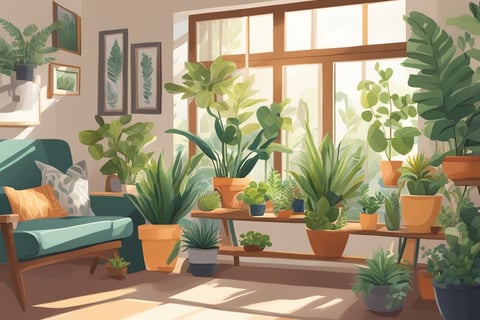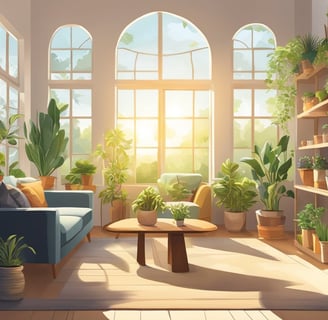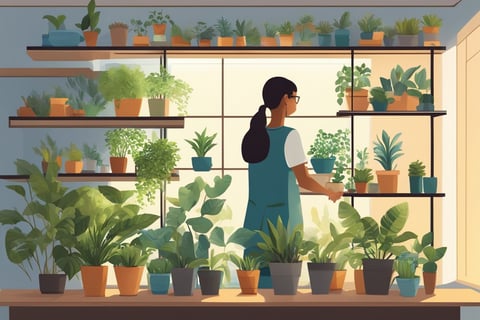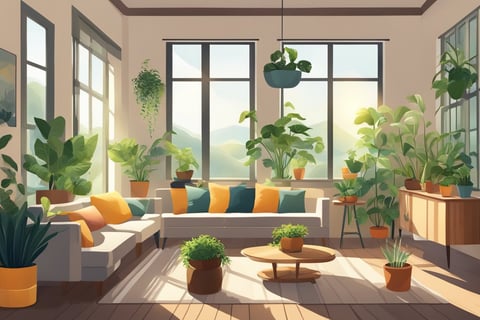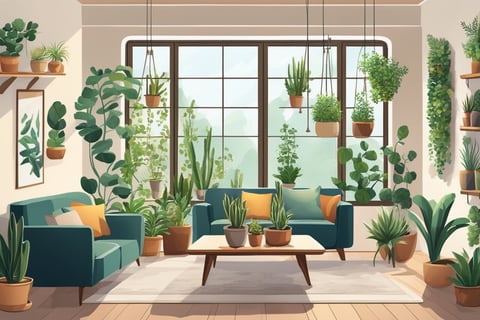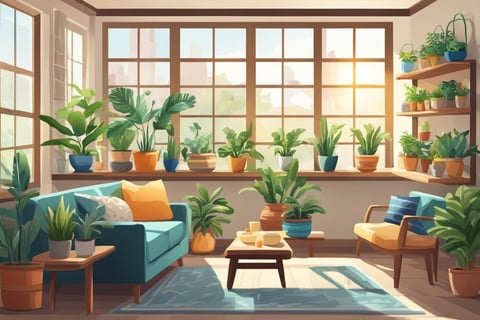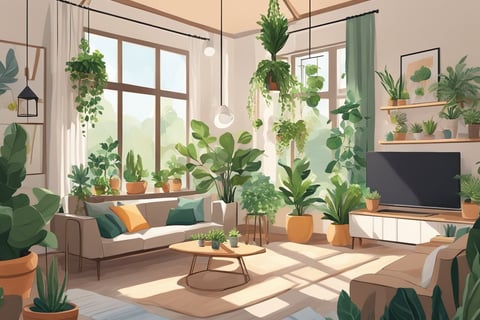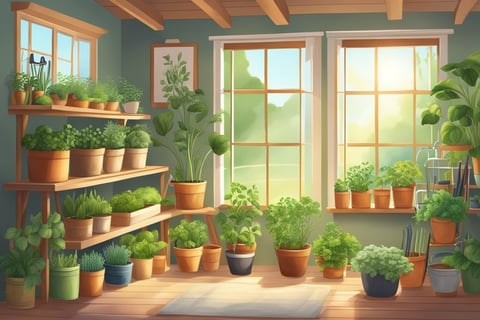The Ultimate Beginner’s Guide to Thriving Indoor Plants: Selection and Care Tips
Bring the beauty of nature indoors with our beginner’s guide to indoor gardening! Learn how to select the best plants for your home based on light, space, and maintenance needs, plus essential tips for watering, feeding, and keeping your plants healthy year-round. Whether you’re new to indoor gardening or looking to expand your plant collection, this guide will help you create a thriving green oasis at home.
11/9/20249 min read
Indoor Gardening 101: How to Choose and Care for the Best Plants
Selecting the right indoor plants can transform any space into a vibrant and inviting haven. Choosing plants based on light levels is crucial, as not all plants thrive in every lighting condition. Low-light areas might be perfect for snake plants or pothos, whereas bright spaces could support succulents or fiddle leaf figs.
Space availability is another factor to consider. Small apartments might benefit from compact options like tabletop ferns, while larger rooms can accommodate bigger species such as rubber plants. Plants not only beautify interiors but also contribute to better air quality by removing toxins and releasing oxygen.
Beginners should focus on easy-to-care-for plants that align with their lifestyle. Opt for resilient varieties that can withstand minor neglect, such as zz plants or spider plants, to ensure a successful and enjoyable indoor gardening experience.
Assessing Your Indoor Environment
Choosing the right indoor plants involves evaluating light levels, available space, and potential air quality benefits. By understanding these factors, one can make informed decisions to create an optimal indoor garden that thrives.
Understanding Light Requirements
Light is crucial for plant growth and varies throughout indoor spaces. Natural light often changes based on the direction windows face. North-facing windows provide low light, while south-facing ones offer bright, direct light. East and west-facing windows receive moderate light levels.
For areas with little natural light, choosing plants like snake plants, pothos, or ZZ plants is wise. These plants adapt well to low-light environments and require minimal sunlight.
Using artificial lighting, like LED grow lights, can supplement areas lacking natural light. Light intensity and duration should mimic natural conditions as closely as possible. Ensure positioning prevents plants from receiving too much direct light, which can scorch foliage. Matching light conditions based on plant needs supports healthy growth and vibrant foliage.
Evaluating Space Constraints
Space availability affects the choice and placement of indoor plants. Before selecting plants, measure available spaces accurately. Consider vertical space by using shelves or hanging planters to maximize smaller areas.
Small plants like succulents or herbs are ideal for limited countertops or shelves. Larger spaces can accommodate sprawling plants like monstera or rubber trees.
Planters come in various sizes and shapes, catering to specific needs. Select ones that fit the desired space without crowding. Allow enough room for plants to grow and expand over time. This approach ensures that each plant has sufficient space for its roots and foliage, facilitating healthy growth.
Considering Air Quality Improvement
Certain indoor plants are known to improve air quality by absorbing toxins and releasing oxygen. Plants such as peace lilies, spider plants, and ferns are effective at filtering indoor air. This can lead to a healthier living environment.
Consider the air-purifying qualities when selecting plants. Those with large leaves or multiple stems often purify air more effectively.
It's beneficial to position these plants in areas you spend most of your time, like living rooms or offices, to maximize their air-cleansing properties. This can contribute to a fresher and more pleasant indoor atmosphere.
Selecting the Right Plants
Successful indoor gardening involves choosing plants that thrive in your specific environment. Consider light conditions, space constraints, and air-quality benefits to find the perfect fit.
Best Plants for Low Light Conditions
Not all indoor environments offer abundant natural light, but many plants can thrive in shaded or low-light areas. Snake Plant (Sansevieria) and ZZ Plant (Zamioculcas zamiifolia) are popular choices, known for their resilience.
Pothos and Philodendron are also suitable, requiring minimal sunlight to thrive. These plants not only adapt well but also help in filtering indoor air. Place them in corners or rooms with indirect sunlight for optimal growth.
Regular watering with a focus on soil moisture helps maintain these plants. Make sure not to overwater, as it can lead to root rot.
Ideal Plants for Limited Spaces
When space is restricted, compact or vertical-growing plants are ideal. Succulents, such as Echeveriaand Haworthia, are excellent due to their small size and minimal care needs.
Spider Plants can be grown in hanging baskets, utilizing vertical space effectively. Small potted Herbs like basil or mint are suited for narrow windowsills or countertops.
These options maximize utility while adding greenery to your space. Succulents require less frequent watering, while spider plants might need more attention to their soil moisture.
Top Air-Purifying Plants
Improving indoor air quality with plants is an accessible way to promote healthier living spaces. Peace Lily (Spathiphyllum) and Aloe Vera are known for their ability to filter pollutants and produce oxygen.
Boston Fern is particularly effective at removing formaldehyde and is well-suited for bathrooms or humid areas. Rubber plants also contribute to cleaner air by absorbing toxins.
Plants should be cared for with appropriate watering schedules and pruning. Peace lilies prefer moist soil, while aloe vera requires less frequent watering and plenty of indirect light. Regular maintenance ensures they continue to benefit the indoor environment effectively.
Plant Care Essentials
Caring for indoor plants involves understanding their basic needs such as watering, fertilizing, pruning, and managing pests. Mastering these essentials helps maintain healthy and thriving plants in your home.
Watering Fundamentals
Proper watering is crucial for indoor plant health. Overwatering is a common mistake, which can lead to root rot. It is important to check the soil moisture before watering—using a finger or a moisture meter can help. The frequency of watering depends on the plant type and environmental conditions like humidity and temperature.
Watering should be thorough enough to reach the roots. A good practice is to water until some liquid drains from the bottom of the pot, ensuring the roots are hydrated. Make sure the pot has proper drainage holes to prevent waterlogging.
Fertilizing Basics
Indoor plants require nutrients to grow, which are provided through fertilizers. Different plants require different types of fertilizers, such as balanced formulas or those higher in nitrogen. Granular and liquidare common fertilizer forms. Liquid fertilizers are often preferred for indoor plants due to ease of application and quicker absorption.
Application frequency varies—some plants need feeding monthly, while others thrive with less frequent fertilizing. It’s important to follow product instructions to avoid nutrient burn. Incorporating organic options like compost tea or worm castings can also be beneficial.
Pruning Techniques
Pruning helps keep plants aesthetically pleasing and healthy by removing dead or overcrowded leaves. Tools like scissors or pruning shears should be clean and sharp to prevent disease and promote a clean cut. Deadheading, the removal of spent flowers, encourages further blooming.
Timing and method of pruning differ for each species. Some plants benefit from regular trimming to maintain shape, while others might need less frequent attention. Leaves that are browning or yellow should be removed to improve appearance and growth.
Pest Prevention and Management
Pests like aphids and spider mites can harm indoor plants. Regular inspection helps detect problems early. Biological controls involve introducing beneficial insects, like ladybugs, which naturally reduce pest populations. Homemade solutions, such as diluted neem oil, can also deter pests without harmful chemicals.
Preventing pest infestations involves creating an environment that does not support their growth. Keeping plants clean by wiping leaves or using gentle sprays can deter many insects. Ensuring proper airflow around plants also reduces the likelihood of pest issues.
Advanced Considerations
To excel at indoor gardening, advanced techniques like understanding potting and repotting, selecting the right soil and fertilizers, and utilizing effective lighting systems are crucial. These aspects ensure healthy plant growth and maintenance in varying indoor environments.
Potting and Repotting Practices
Proper potting and repotting are vital for plant health. Choosing the correct pot size is crucial; too small can restrict growth, and too large may lead to overwatering. Plants generally need repotting every 1-2 years, or when roots outgrow their containers.
Drainage is essential. Pots should have drainage holes to prevent water accumulation, which can cause root rot. Using a saucer can catch excess water without making a mess.
When repotting, gently loosen the roots and trim if necessary. This encourages new growth and ensures that the plant can establish itself in its new home. Repotting is best done during the plant's most active growth period.
Choosing Soil and Fertilizers
The right soil mix provides necessary nutrients and adequate drainage. For most indoor plants, a standard potting mix works well. Cacti and succulents need a gritty, well-draining mix, while orchids thrive in bark-based soil.
Fertilization is important to cover nutrient needs. There are various types: liquid, slow-release, or granular. Liquid fertilizers are ideal for prompt nutrient boost, while slow-release types ensure a steady supply.
Soil choice matters significantly; invest in high-quality products from reputable brands to avoid pests and diseases. Regularly replacing soil, especially when repotting, helps maintain a healthy environment for plant roots.
Lighting Systems for Indoor Gardening
Effective lighting is pivotal, especially for spaces lacking natural sunlight. Fluorescent lights are cost-effective and beneficial for growing leafy greens and herbs. LED grow lights are energy-efficient, providing light that closely mimics the sun.
Positioning and intensity are key. Adjust the lights closer to plants for optimal growth and move for higher light conversions. Time systems to mimic natural daylight may be advantageous.
Lighting kits can offer a range of color temperatures. This can affect plant growth and flowering. Selecting the proper spectrum ensures that plants receive light best suited for photosynthesis and growth stages.
Seasonal Indoor Plant Care
Indoor plants thrive when their care is adjusted according to the season. As light and temperature vary throughout the year, so do their needs.
Spring and Summer: These seasons typically bring increased sunlight and growth. Indoor plants may require more water as evaporation rates rise. A liquid fertilizer can support this growth. Ensure plants receive adequate light by placing them near sunny windows.
Fall and Winter: During these cooler months, indoor plants may enter a dormant phase. Reduce watering frequency and stop fertilizing. It's important to keep them away from drafts and cold windows. Indirect light may be best as the sun's intensity diminishes.
General Tips:
Humidity: Use a humidifier to combat dry air during winter.
Pruning: Remove dead or yellowing leaves to keep plants healthy.
Rotation: Rotate plants every few weeks for even growth.
Understanding and adjusting to the seasonal changes ensures healthy, thriving indoor plants year-round.
Designing Your Indoor Garden Aesthetically
Selecting the right plants and arranging them thoughtfully can transform any interior space. Begin by assessing the room’s size and the available space for plants. Vertical shelves or hanging planters can make the most of limited floor space. Large plants like fiddle-leaf figs can serve as statement pieces in spacious areas.
The choice of pots and planters should complement existing decor. Opt for neutral tones or bold colors to match the room's theme. Materials such as ceramic, metal, or woven baskets offer diverse textures and visual interest.
Consider using a mix of plant sizes and shapes to create dynamic visual layers. Tall, slender plants paired with shorter, bushier ones add dimension. Trailing vines can soften hard lines on bookshelves or wall edges.
Lighting plays a crucial role in plant placement. Position low-light plants, such as snake plants, in dim corners. Bright spots are ideal for high-light varieties like succulents. Ensuring each plant is in its optimal light condition enhances growth and appearance.
Incorporate multi-functional furniture like plant stands or side tables with plant holders. This provides utility while seamlessly integrating greenery into living spaces. Layering different heights adds depth and texture to the arrangement.
Enhance air quality and ambiance by incorporating fragrant plants like lavender or jasmine. Not only do they improve the air, but they also provide a soothing scent. For a sleek, modern look, choose plants with clean lines and minimal foliage.
By considering these elements, anyone can design an indoor garden that is both functional and visually appealing.
Growing Edible Plants Indoors
Cultivating edible plants indoors is both practical and rewarding. Herbs like basil, mint, and parsley thrive in indoor environments and provide fresh flavors for cooking.
For small spaces, consider using vertical gardens or hanging planters to maximize the area.
Light Levels:
Bright indirect light: Ideal for herbs such as basil and oregano.
Low light: Consider growing mint, which adapts well to lower light conditions.
Space Availability:
Choose smaller varieties of plants if space is limited. Cherry tomatoes and radishes can grow in compact spaces like kitchen windowsills or small planters.
Air Quality Benefits:
Many edible plants help improve indoor air quality. Herbs like rosemary can reduce certain air pollutants. They are a great supplement to your air purification efforts.
Plant Care Essentials:
Watering: Ensure consistent moisture without waterlogging. Most herbs prefer slightly moist soil.
Soil: Use well-draining potting mixes to prevent root rot.
Fertilizing: Apply a balanced liquid fertilizer every 6-8 weeks to support growth.
Proper care will lead to thriving plants ready for fresh, home-grown produce.
By understanding light conditions and space limitations, anyone can successfully grow edible plants indoors.
